Adhesion of Varnish Coatings as a Background for Analogue and Digital Printing Technologies
Abstract
:1. Introduction
2. Materials and Methods
2.1. Visual Assessment
2.2. Surface Topography
2.3. Roughness
2.4. Contact Angle
2.5. Adhesion of Coatings
3. Results
3.1. Visual Assessment
3.2. Contact Angle
4. Conclusions
- Tested surfaces were characterized by Ra values in the range of 0.5–1.2 µm, and contact angle ϴ was in the range of 63.60 ÷ 88.14° for individual surfaces.
- The power of the radiators and speed of the line have a greater influence on the formation of the contact angle than the amount of liquid materials applied on each roller machine.
- The speed of the line is important for the formation of the contact angle at the same power of the lamp.
- No correlation between the change in the contact angle and recorded roughness index was observed.
- Final coatings exhibited lower γS values than interlayer coatings. A clear influence of the dispersion component on the formation of γS values was observed. No clear effect of the applied curing parameters on the value of the γSd component was noted.
- The obtained coatings were characterized by high Wa values, ranging from 75.79–97.94 mJ/m2. For the individual systems, the level of Wa values achieved depended primarily on the type of individual varnish product layers. The relationship between Wa and its components, Wad and Wap, provided favorable conditions for obtaining coatings with high adhesion in the finishing process.
- The adhesion of individual layers to the HDF board’s surface and the interlayer system in the analyzed systems ranged from 1.25–1.56 MPa. However, cohesive-type delamination in the HDF board was clearly the dominant delamination mechanism under destructive loads.
- The substrate refinement parameters adopted in the roller refinement provide favorable conditions for obtaining final finishes in terms of adequate adhesion. This applies to the doses of energy distributed by the radiators, in Ga, Hg, and LED versions, the module focusing the electromagnetic radiation beam, and the distance of the radiator from the cured surface layers and varnish coatings.
Author Contributions
Funding
Institutional Review Board Statement
Informed Consent Statement
Data Availability Statement
Acknowledgments
Conflicts of Interest
References
- Bartoszuk, K.; Kowaluk, G. The Influence of the Content of Recycled Natural Leather Residue Particles on the Properties of High-Density Fiberboards. Materials 2023, 16, 5340. [Google Scholar] [CrossRef] [PubMed]
- Henke, M.; Lis, B.; Krystofiak, T. Mechanical and Chemical Resistance of UV Coating Systems Prepared under Industrial Conditions. Materials 2023, 16, 4468. [Google Scholar] [CrossRef] [PubMed]
- Rahaman, M.; Hossain, S.; Islam, M.; Uddin, M. Suitability of Medium Density Fiber Board Made From Rubber Wood for Household and Industrial Use. Bangladesh J. Agric. Res. 2021, 46, 203–209. [Google Scholar] [CrossRef]
- Pawlak, D.; Boruszewski, P. Digital printing in wood industry. Ann. WULS For. Wood Technol. 2020, 109, 109–115. [Google Scholar] [CrossRef]
- Sang, R.; Manley, A.; Wu, Z.; Feng, X. Digital 3D Wood Texture: UV-Curable Inkjet Printing on Board Surface. Coatings 2020, 10, 1144. [Google Scholar] [CrossRef]
- Mendes, C.; Oliveira, J.; Etxebarria, I.; Vilas, J.; Lanceros-Méndez, S. State-of-the-Art and Future Challenges of UV Curable Polymer-Based Smart Materials for Printing Technologies. Adv. Mater. Technol. 2019, 4, 1800618. [Google Scholar] [CrossRef]
- Altun, S.; Köse, D. Some of the Physical Properties of UV Jet Printed Furniture Surfaces. Drv. Ind. 2013, 64, 39–43. [Google Scholar] [CrossRef]
- Rawat, R.S.; Nidhi Chouhan, N.; Talwar, M.; Diwan, R.K.; Tyagi, A.K. UV coatings for wooden surfaces. In Progress in Organic Coatings; MDPI: Basel, Switzerland, 2019; Volume 135, pp. 490–495. ISSN 0300-9440. [Google Scholar] [CrossRef]
- Lu, Q.; Zhang, C.; Huang, B.; Wei, X.; Wang, Y. Study on the Application of UV Ink in Printing Manufacturing. In Advances in Graphic Communication, Printing and Packaging Technology and Materials; Springer: Berlin/Heidelberg, Germany, 2021; pp. 629–636. [Google Scholar] [CrossRef]
- Sang, R.; Yang, S.; Fan, Z. Effects of MDF Substrate Surface Coating Process on UV Inkjet Print Quality. Coatings 2023, 13, 970. [Google Scholar] [CrossRef]
- Ozdemir, T.; Bozdoğan, Ö.; Mengeloglu, F. Effects of Varnish and Film Thickness on Adhesion Strength of Coated Wood. Proligno 2013, 9, 164–168. [Google Scholar]
- Nkeuwa, W.N.; Riedl, B.; Landry, V. Wood surfaces protected with transparent multilayer UV-cured coatings reinforced with nanosilica and nanoclay. Part I: Morphological study and effect of relative humidity on adhesion strength. J. Coat Technol. Res. 2014, 11, 283–301. [Google Scholar] [CrossRef]
- Kılıç, K.; Söğütlü, C. Varnish Adhesion Strength in Natural Aged Wood Material. Politek. Derg. J. Polytech. 2023, 26, 847–854. [Google Scholar] [CrossRef]
- Vitosytė, J.; Ukvalbergienė, K.; Keturakis, G. The Effects of Surface Roughness on Adhesion Strength of Coated Ash (Fraxinus excelsior L.) and Birch (Betula L.) Wood. Mater. Sci. 2012, 18, 347–351. [Google Scholar] [CrossRef]
- Iis, Y.; Istie, R.; Lumongga, D.; Darmawan, W. Wettability and adherence of acrylic paints on long and short rotation teaks. Wood Mater. Sci. Eng. 2019, 15, 229–236. [Google Scholar] [CrossRef]
- Pecina, H.; Paprzycki, O. Lack auf Holz. In Lacquers on the Wood; Vincentz Verlag: Hannover, Germany, 1995; p. 175. [Google Scholar]
- Ozdemir, T.; Hiziroglu, S. Evaluation of surface quality and adhesion strength of treated solid wood. J. Mater. Process. Technol. 2007, 186, 311–314. [Google Scholar] [CrossRef]
- Ozdemir, T.; Hiziroglu, S. Influence of surface roughness and species on bond strength between the wood and the finish. For. Prod. J. 2009, 59, 90–94. [Google Scholar]
- Ozdemir, T.; Hiziroglu, S.; Kocapınar, M. Adhesion Strength of Cellulosic Varnish Coated Wood Species as Function of Their Surface Roughness. Adv. Mater. Sci. Eng. 2015, 2015, 525496. [Google Scholar] [CrossRef]
- Guo, X.; Li, R.; Teng, Y.; Cao, P.; Wang, X.; Ji, F.; Vohringer, S. Effects of surface treatment on the properties of UV coating. Wood Res. 2015, 60, 629–638. [Google Scholar]
- Jung, S.J.; Lee, S.J.; Cho, W.J.; Ha, C.S. Synthesis and properties of UV-curable waterborne unsaturated polyester for wood coating. J. Appl. Polym. Sci. 1998, 69, 695–708. [Google Scholar] [CrossRef]
- Mashouf, G.; Ebrahimi, M.; Bastani, S. UV curable urethane acrylate coatings formulation: Experimental design approach. Pigment Resin Technol. 2014, 43, 61–68. [Google Scholar] [CrossRef]
- Dai, J.; Ma, S.; Wu, Y.; Liu, X. High bio-based content waterborne UV-curable coatings with excellent adhesion and flexibility. Prog. Org. Coat. 2015, 87, 197–203. [Google Scholar] [CrossRef]
- Dai, J.; Ma, S.; Liu, X.; Han, L.; Wu, Y.; Dai, X.; Zhu, J. Synthesis of bio-based unsaturated polyester resins and their application in waterborne UV-curable coatings. Prog. Org. Coat. 2015, 78, 49–54. [Google Scholar] [CrossRef]
- Yan, X.; Qian, X.; Lu, R.; Miyakoshi, T. Synergistic Effect of Addition of Fillers on Properties of Interior Waterborne UV-Curing Wood Coatings. Coatings 2018, 8, 9. [Google Scholar] [CrossRef]
- Gurleyen, L.; Ayata, U.; Esteves, B.; Cakicier, N. Effects of heat treatment on the adhesion strength, pendulum hardness, surface roughness, color and glossiness of Scots pine laminated parquet with two different types of UV varnish application. Maderas. Cienc. Y Tecnol. 2017, 19, 213–224. [Google Scholar] [CrossRef]
- Çavuş, V. Weathering Performance of Mulberry Wood with UV Varnish Applied and Its Mechanical Properties. Bioresources 2021, 16, 6791–6798. [Google Scholar] [CrossRef]
- Bekhta, P.; Lis, B.; Krystofiak, T.; Tokarczyk, M.; Bekhta, N. Gloss of Varnished MDF Panels Veneered with Sanded and Thermally Compressed Veneer. Coatings 2022, 12, 913. [Google Scholar] [CrossRef]
- Salca, E.A.; Krystofiak, T.; Lis, B.; Mazela, B.; Proszyk, S. Some Coating Properties of Black Alder Wood as a Function of Varnish Type and Application Method. Bioresources 2016, 11, 7580–7594. [Google Scholar] [CrossRef]
- Hazir, E.; Koc, K.H. Evaluation of wood-based coating performance for ultraviolet roller and conventional air-atomization processes, Maderas. Cienc. Y Tecnol. 2021, 23, 1–16. [Google Scholar] [CrossRef]
- Kaygin, B.; Akgun, E. Comparison of Conventional Varnishes with Nanolacke UV Varnish With Respect to Hardness and Adhesion Durability. Int. J. Mol. Sci. 2008, 9, 476–485. [Google Scholar] [CrossRef]
- Gürleyen, L. Effects of Artificial Weathering on the Color, Gloss, Adhesion, and Pendulum Hardness of UV System Parquet Varnish Applied to Doussie (Afzelia africana) Wood. BioResources 2021, 16, 1616–1627. [Google Scholar] [CrossRef]
- Anonymous Theta Flex User Manual–OneAttension Original Instructions; Biolin Scientific Oy: Espoo, Finland, 2019; p. 74.
- ISO 4287 (1998); Geometrical Product Specification (GPS)—Surface Texture: Profile Method—Terms, Definitions and Surface Texture Parameters. International Organization for Standardization: Geneva, Switzerland, 1998.
- PN-EN 828; Adhesives—Determination of Wettability by Measuring the Contact Angle and Surface Free Energy of a Solid Surface. iTeh Standard: Etobicoke, ON, Canada, 2013.
- PN-EN 4624; Paints and Varnishes—Pull-Off Test for Adhesion. iTeh Standard: Etobicoke, ON, Canada, 2023.
- Białecki, F.; Pohl, P.; Sydor, M. Investigations on sealing material consumption in relation with the roughness parameters of HDF boards. EJPAU 2008, 11, 17. [Google Scholar]
- Park, J.W.; Shim, G.S.; Lee, J.G.; Jang, S.W.; Kim, H.J.; Choi, J.N. Evaluation of UV Curing Properties of Mixture Systems with Differently Sized Monomers. Materials 2018, 11, 509. [Google Scholar] [CrossRef] [PubMed]
- Park, J.W.; Shim, G.S.; Back, J.H.; Kim, H.J.; Shin, S.; Hwang, T.S. Characteristic shrinkage evaluation of photocurable materials. Polym. Test. 2016, 56, 344–353. [Google Scholar] [CrossRef]
- Sanai, Y.; Ninomiya, T.; Arimitsu, K. Improvements in the physical properties of UV-curable coating by utilizing type II photoinitiator. Prog. Org. Coat. 2021, 151, 106038. [Google Scholar] [CrossRef]
- Papp, E.; Csiha, C. Contact angle as function of surface roughness of different wood species. Surf. Interfaces 2017, 8, 54–59. [Google Scholar] [CrossRef]
- Yu, Q.; Pan, X.; Yang, Z.; Zhang, L.; Cao, J. Effects of the Surface Roughness of Six Wood Species for Furniture Production on the Wettability and Bonding Quality of Coating. Forests 2023, 14, 996. [Google Scholar] [CrossRef]
- Casilla, R.C.; Chow, S.; Steiner, P.R. An immersion technique for studying wood wettability. Wood Sci. Technol. 1981, 15, 31–43. [Google Scholar] [CrossRef]
- Wang, X.F.; Wei, X.F.; Huang, P.Q. Study on Performance of Adherence of Water-Base UV Varnish. Adv. Mater. Res. 2010, 174, 409–413. [Google Scholar] [CrossRef]
- Schultz, J.; Nardin, M. Theories and mechanisms of adhesion. In Adhesion Promotion Techniques: Technological Applications; Mittal, K.L., Pizzi, A., Eds.; Marcel Dekker: New York, NY, USA, 2002; pp. 1–26. [Google Scholar]
- Packham, D.E. The mechanical theory of adhesion. In Handbook of Adhesive Technology; Pizzi, A., Mittal, K.L., Eds.; Marcel Dekker Inc.: New York, NY, USA, 2003; pp. 69–93. [Google Scholar]
- PL234055B1. Method for Manufacturing a Cellular Plate and a Cellular Plate Manufactured by This Method. Author Maciej Tokarczyk/BORNE Furniture Comp/. Available online: https://www.patentguru.com/PL234055B1 (accessed on 2 December 2023).

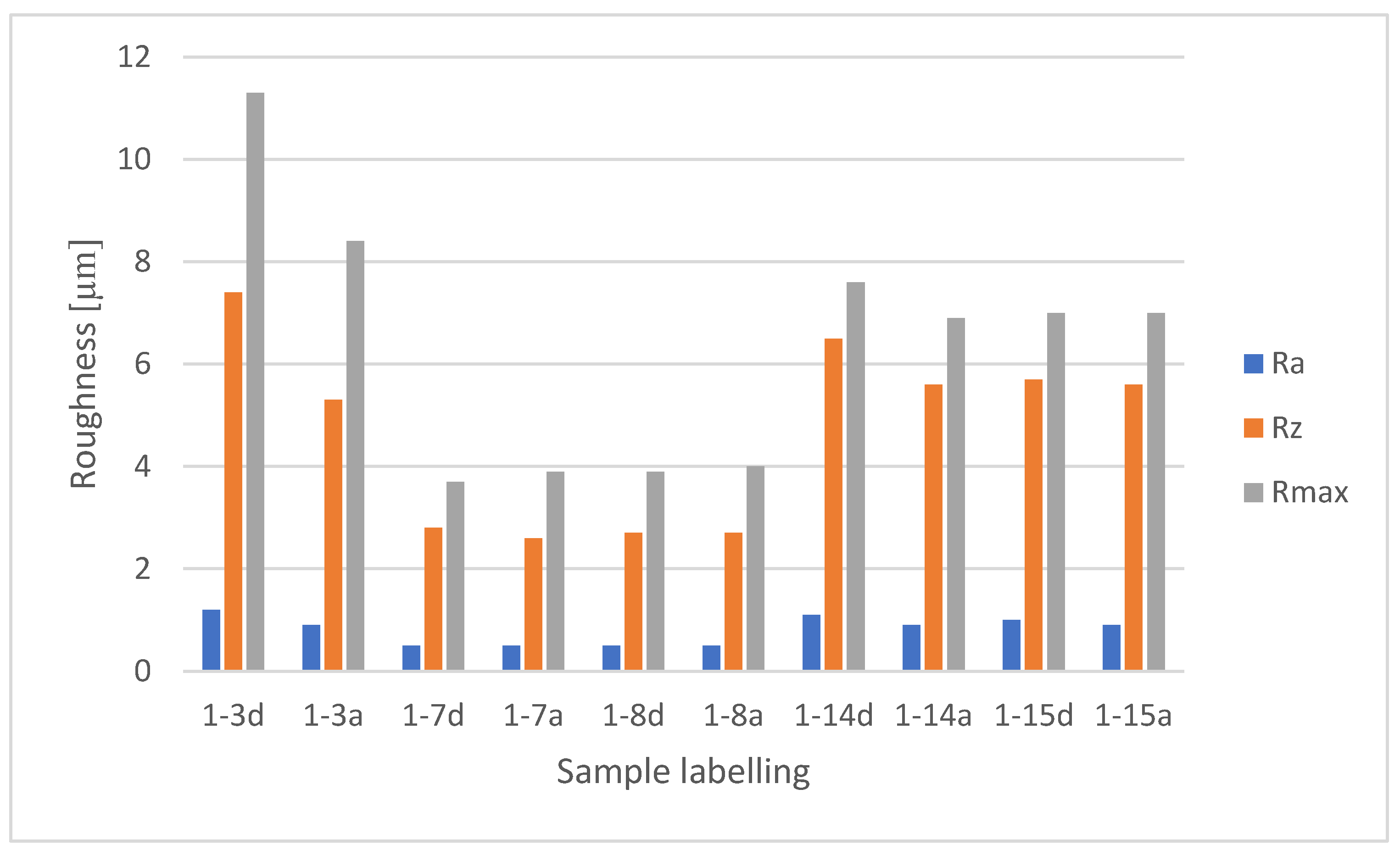
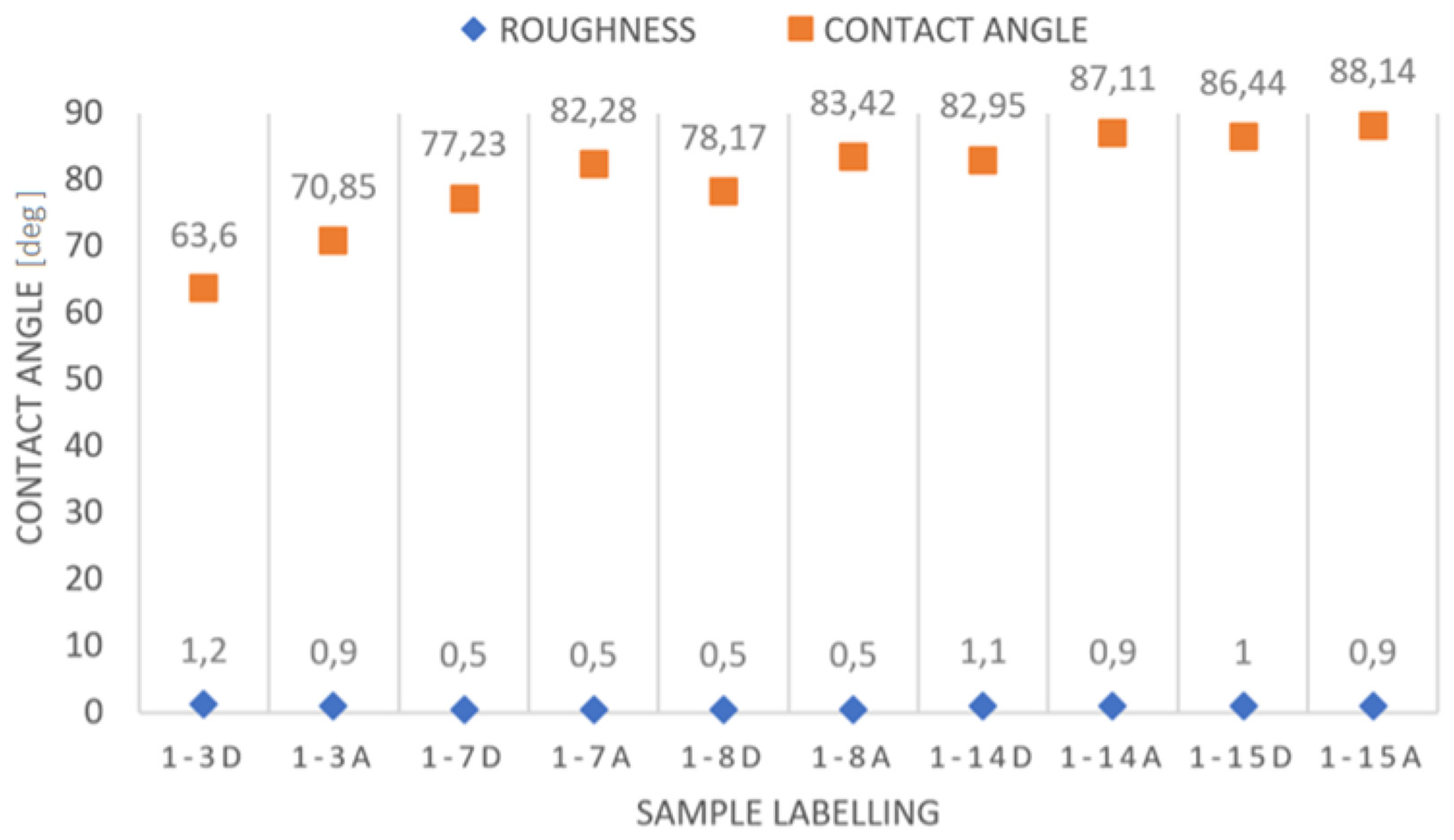
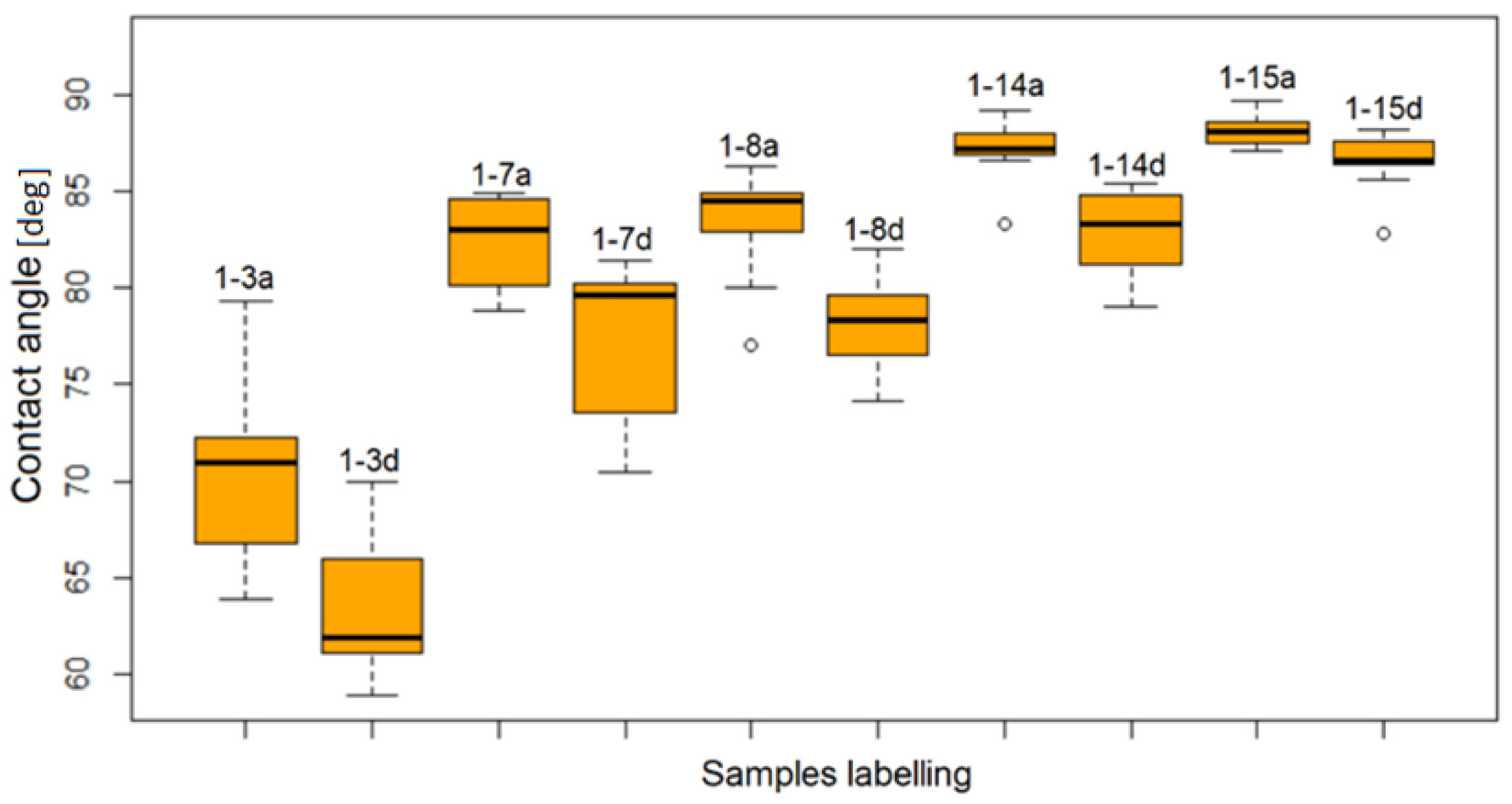

| Name of UV Varnish Products | |||
|---|---|---|---|
| Properties | Q-UV 03040 Putty | IQ-UVC03284 Basecoat | IQ-UVC03392 Topcoat |
| Polymer base | acrylic | acrylic | acrylic |
| Color | colorless | white | white |
| Solid content [%] | 95.3 ± 3 | 97.6 ± 3 | 97.6 ± 3 |
| Viscosity of delivery | 65–85 | 90–140 | 35–50 |
| (flow cup 8 mm) | (flow cup 6 mm) | (flow cup 6 mm) | |
| Brookfield CAP 2000+/cone 2 [mPa·s] | 1100–1500 | - | - |
| Processing temperature [°C] | Between 20–50 | ||
| Labeling of Samples (Systems) | Operations Performed in Preparation of the Test Substrate | Speed of Line [m/min] |
|---|---|---|
| 1-3d | The surface of a cellular board with 1 layer 30 g/m2 of a putty at the maximum setting of lamps focusing a beam of electromagnetic radiation | 40 |
| 1-3a | The surface of a cellular board with 1 layer 30 g/m2 of a putty at the maximum setting of lamps focusing a beam of electromagnetic radiation | 25 |
| 1-7d | The surface of a cellular board with 1 layer of a filler with increased input, 1 layer of a filler with decreased input, and 1 primer at the maximum setting of lamps focusing a beam of electromagnetic radiation behind the 2 filler and maximum setting of LED modules behind the 1 basecoat 20 g/m2 | 40 |
| 1-7a | The surface of a cellular board with 1 layer of a filler with increased input, 1 layer of a filler with decreased input, and 1 primer at the maximum setting of lamps focusing a beam of electromagnetic radiation behind the 2 filler and maximum setting of LED modules behind the 1 basecoating 20 g/m2 | 25 |
| 1-8d | The surface of a cellular board with 1 layer of a putty with increased input, 1 layer of a filler with decreased input, and 1 primer at 50% setting of lamps focusing a beam of electromagnetic radiation behind the 2 filler and maximum setting of LED modules behind the 1 basecoating 10 g/m2 | 40 |
| 1-8a | The surface of a cellular board with 1 layer of a putty with increased input, 1 layer of a putty with decreased input, and 1 primer at 50% setting of lamps focusing a beam of electromagnetic radiation behind the 2 filler and maximum setting of LED modules behind the 1 basecoating 10 g/m2 | 25 |
| 1-14d | The surface of a cellular board with 2 layers of a putty, 2 layers of a primer using OPTI, and 2 layers of topcoat 12 g/m2 at the maximum setting of lamps focusing a beam of electromagnetic radiation and maximum for each LED module. | 40 |
| 1-14a | The surface of a cellular board with 2 layers of a putty, 2 layers of a primer using OPTI, and 2 layers 12 g/m2 of topcoat at the maximum setting of lamps focusing a beam of electromagnetic radiation and maximum for each LED module. | 25 |
| 1-15d | The surface of a cellular board with 2 layers of a putty, 2 layers of a primer using OPTI, and 1 layer 6 g/m2 of topcoat at the maximum setting of lamps focusing a beam of electromagnetic radiation and maximum for each LED module. | 40 |
| 1-15a | The surface of a cellular board with 2 layers of a putty, 2 layers of a primer using OPTI and 1 layer of topcoat 6 g/m2 at the maximum setting of lamps focusing a beam of electromagnetic radiation and maximum for each LED module. | 25 |
| Method | Fringe Projection Phase-Shifting |
|---|---|
| XY pixel size | 1.1 μm × 1.1 μm |
| Measured range in Z direction | 1–60 μm |
| Lateral sampling (XY) | 1.41 mm × 1.06 mm |
| Measurement speed | 5–30 s (1280 × 960 measurement points) |
| Imaging options | Optical image, 2D and 3D roughness graphs |
| Method | Fringe projection phase-shifting |
| XY pixel size | 1.1 μm × 1.1 μm |
| Measured range in Z direction | 1–60 μm |
| Lateral sampling (XY) | 1.41 mm × 1.06 mm |
| Detachment Type | Detachment Occurring in a Given System |
|---|---|
| A | Cohesive in a substrate |
| A/B | Adhesive between a substrate and the first coating |
| B | Cohesive in the first coating |
| B/C | Adhesive between the first and second coating |
| -/Y | Adhesive of the last coating and glue |
| Y | Cohesive in glue |
| Y/Z | Adhesive between glue and a measuring stamp |
| Sample Labelling | Surface Topography |
|---|---|
| 1-3a |  |
| 1-7a |  |
| 1-8a | 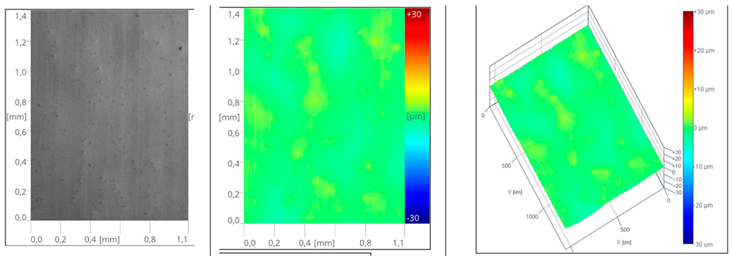 |
| 1-14a |  |
| 1-14a | 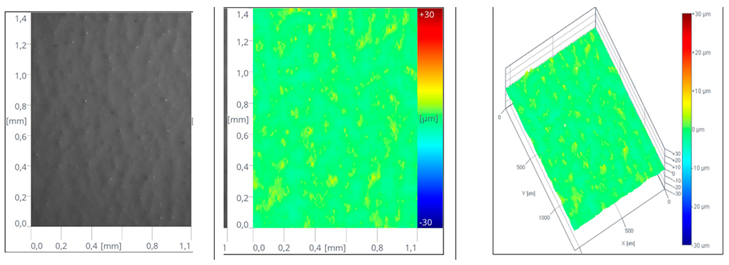 |
| Samples | Speed [m/min] | Amount for Last Layer [g/m2] | Type | Wavelength Range | Power Peak [mW/cm2] | Energy Density [mJ/cm2] |
|---|---|---|---|---|---|---|
| 1-3d | 40 | 30 | putty | UVV | 1050 | 85 |
| UVA | 1155 | 90 | ||||
| 1-3a | 25 | 30 | putty | UVV | 1065 | 135 |
| UVA | 1170 | 150 | ||||
| 1-7d | 40 | 20 | basecoat | UVV | 11,550 | 575 |
| 1-7a | 25 | 20 | basecoat | UVV | 11,567 | 922 |
| 1-8d | 40 | 10 | basecoat | UVV | 11,550 | 575 |
| 1-8a | 25 | 10 | basecoat | UVV | 11,567 | 922 |
| 1-14d | 40 | 12 | topcoat | UVV | 7050 | 505 |
| UVA | 2860 | 305 | ||||
| 1-14a | 25 | 12 | topcoat | UVV | 7050 | 800 |
| UVA | 2860 | 490 | ||||
| 1-15d | 40 | 6 | topcoat | UVV | 7050 | 505 |
| UVA | 2860 | 305 | ||||
| 1-15a | 25 | 6 | topcoat | UVV | 7050 | 810 |
| UVA | 2860 | 485 |
Disclaimer/Publisher’s Note: The statements, opinions and data contained in all publications are solely those of the individual author(s) and contributor(s) and not of MDPI and/or the editor(s). MDPI and/or the editor(s) disclaim responsibility for any injury to people or property resulting from any ideas, methods, instructions or products referred to in the content. |
© 2023 by the authors. Licensee MDPI, Basel, Switzerland. This article is an open access article distributed under the terms and conditions of the Creative Commons Attribution (CC BY) license (https://creativecommons.org/licenses/by/4.0/).
Share and Cite
Tokarczyk, M.; Lis, B.; Salca, E.A.; Krystofiak, T. Adhesion of Varnish Coatings as a Background for Analogue and Digital Printing Technologies. Appl. Sci. 2024, 14, 304. https://doi.org/10.3390/app14010304
Tokarczyk M, Lis B, Salca EA, Krystofiak T. Adhesion of Varnish Coatings as a Background for Analogue and Digital Printing Technologies. Applied Sciences. 2024; 14(1):304. https://doi.org/10.3390/app14010304
Chicago/Turabian StyleTokarczyk, Maciej, Barbara Lis, Emilia Adela Salca, and Tomasz Krystofiak. 2024. "Adhesion of Varnish Coatings as a Background for Analogue and Digital Printing Technologies" Applied Sciences 14, no. 1: 304. https://doi.org/10.3390/app14010304






